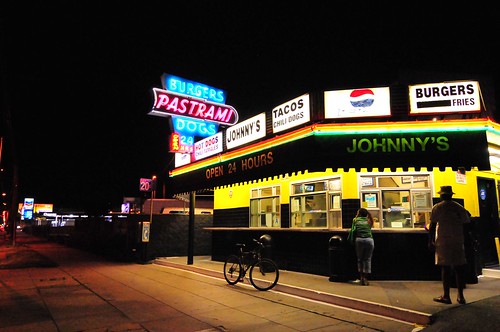It’s curious to think about eateries in time-context rather than categories of food types. In this case late night workers, people out after bar-hopping, people who just don’t cook at home and have midnight cravings. The neighborhood here is somewhat borderline in terms of its geography. It’s several blocks from a university and a designated buffer zone of historical significance — the West Adams section of Los Angeles. It’s a fascinating neighborhood if only for the enormous mansions — once single family, now single room occupancy or kind of dumpy shares; cars parked on the lawn; lots of bars up on windows. It’s the kind of place where a food service window will do a brisk trade.
I have a continuing and long fascination with night culture, especially in urban settings, largely for the visual impact of the small, lit oasis amongst stretches of emptiness. Urban living is difficult to imagine before street lighting, honestly.
When I first moved back to New York City in the summer of 1995, I shared a two bedroom dump at 202 Front Street in the DUMBO section of Brooklyn before it became quite posh. I was fascinated by the all-night Bodega. They were often brightly lit places, with Christmas lights set about them and stacks of cereal boxes and laundry detergent piled in the windows. I naively set out to photograph them, cruising the back end of Brooklyn (Prospect Heights, before it was posh) in my brother’s band-van — think something that looked like either a beat-up surveillance van, or the thing the guy who’s the child molester in the movie drives. I found out quite roughly that these were more often fronts for small-scale drug dealing than places where you get laundry soap in the middle of the night.
